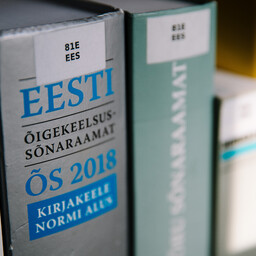The new Orthographic Dictionary (ÕS) will be published in December 2025. It will serve as the standard for written language starting from January 1, 2026. The ÕS includes new Estonian words and updated information on word inflection, derivation, and spelling.
The ÕS will be published both online and in print. The content of both versions is the same. The online ÕS will remain unchanged. The printed edition will be published at the end of October.
Sirli Zupping, head of the Modern Estonian Language Department at the Estonian Language Institute (EKI), says that the size and number of pages of the printed ÕS are similar to the previous edition. The online ÕS is accessible to users on the EKI website.
The new ÕS is 12 centimeters thick. Zupping says: 'It is not possible to bind a thicker book in Estonia.'
Zupping describes the compilation of the new ÕS as an enjoyable task. The team was enthusiastic. 'There were both former employees and those who compile the unified dictionary. A total of 18 people with a very high work ethic,' said Zupping.
The new ÕS is similar to previous editions, but the content has been updated. The Language Committee made ten decisions regarding the standard of written language.
According to the new ÕS, it is standard to write 'Araabia number' with a capital initial letter. Similarly, 'Araabia maad' is written. Previously, the capitalized supplementary word 'Araabia' referred only to the Arabian Peninsula.
Standard parallel inflection applies to the following words: õudne, õudse / õudne, õudsa; viis, viit / viis, viite; kuus, kuut / kuus, kuute. Acceptable written forms include both 'gala' and 'gaala' as well as 'karate' and 'karatee'.
For the adjective 'rikas', both weak ('rikast', 'rikastes') and strong forms ('rikkat', 'rikkates') are standard. The noun 'rikas' is inflected only according to the weak seventh declension ('rikas : rikka : rikast').
Zupping says: 'It is also important to note that all new decisions and additions in the ÕS and EKI's unified dictionary provide additional options for language users, rather than prohibiting previous usage.'
The new ÕS includes approximately 1,500 new words. These include 'digistress', 'riigikaitsemaks', 'üleminekukool', 'hajatootmine', 'õpiamps', 'vegeburger', 'kliimaärevus', and 'mükoplast'. Zupping says: 'As can be seen, new words in Estonian are mostly compound words.'
The new ÕS contains around 60,000 headwords. Complete information on Estonian words is available in EKI's Wordweb, which is continuously updated. The unified dictionary is consistent with the new ÕS and the standard of written language.

